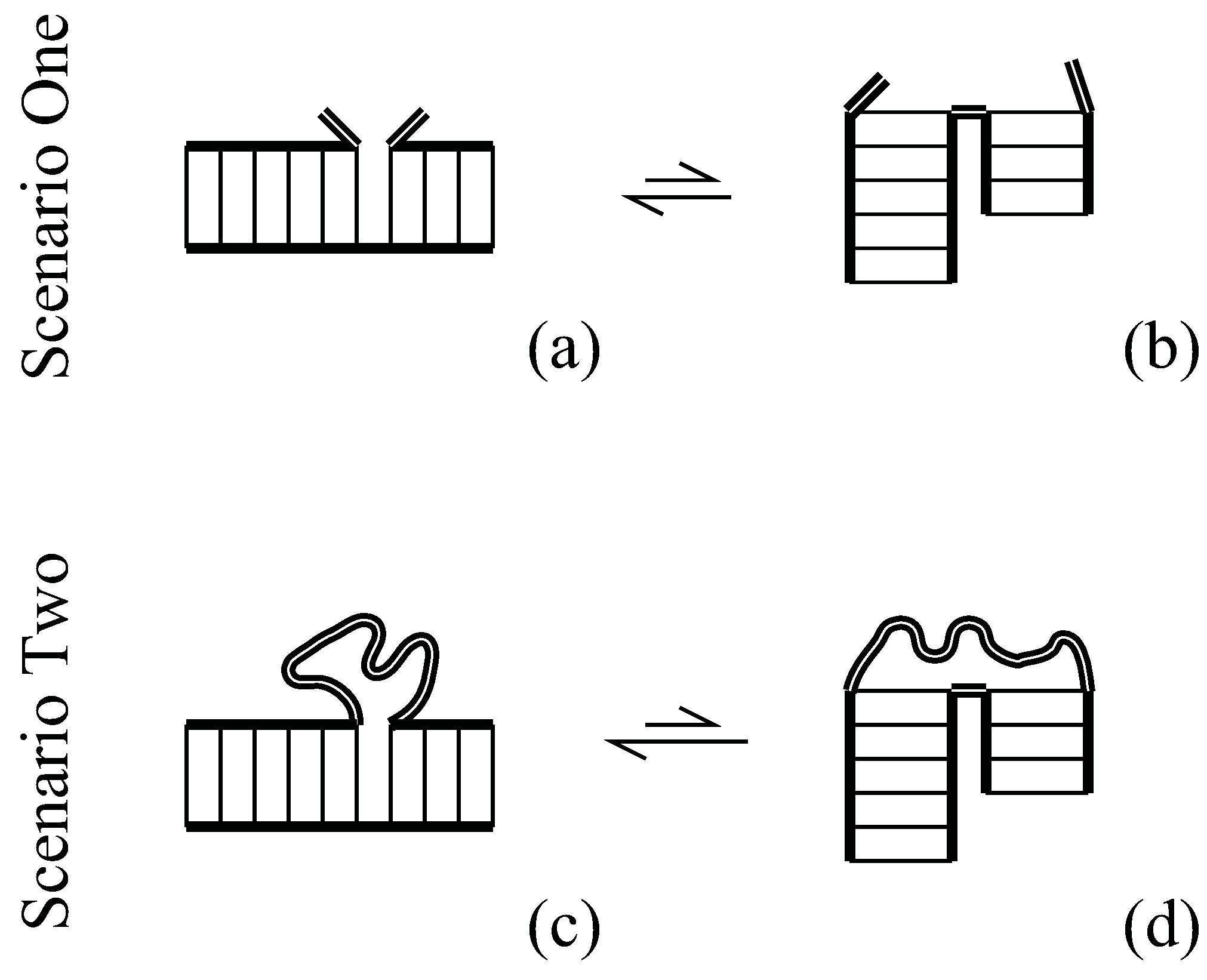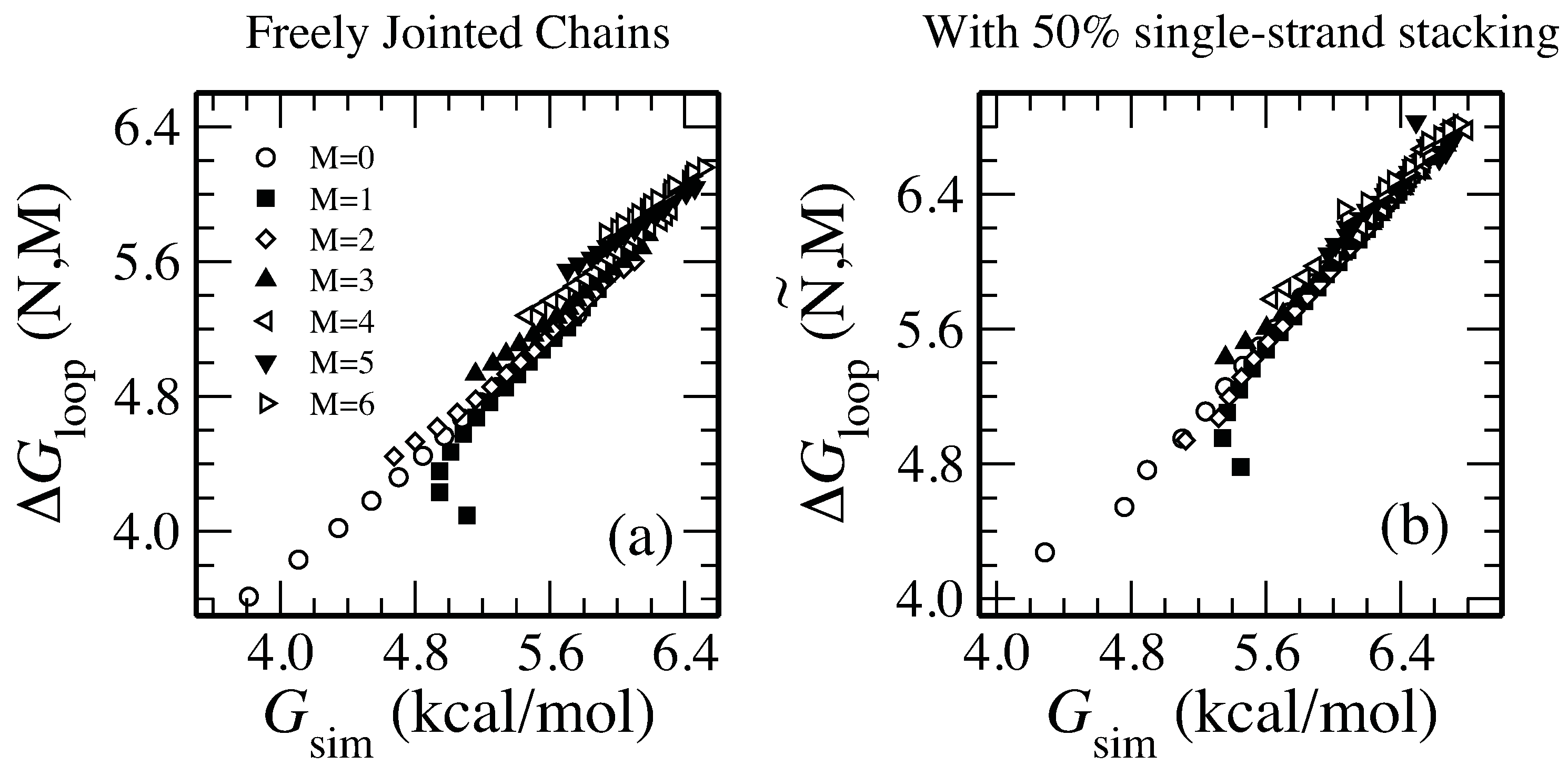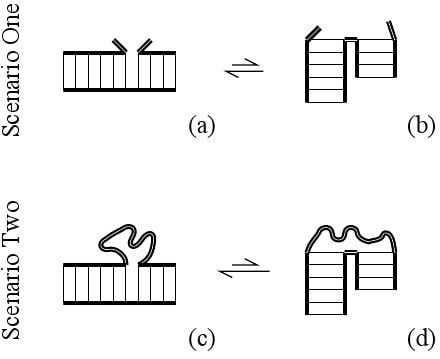Loop Entropy Assists Tertiary Order: Loopy Stabilization of Stacking Motifs
Abstract
:1. Introduction


2. Methods
2.1. Phantom-Chain Approximation
2.2. Self-Avoiding Chain Approximation
2.3. FJC2 Simulations, Including Base-Stacking in Loops

3. Conclusions
Acknowledgements
References
- Mathews, D.H.; Sabina, J.; Zuker, M.; Turner, D.H. Expanded sequence dependence of thermodynamic parameters provides robust prediction of RNA secondary structure. J. Mol. Biol. 1999, 288, 911–940. [Google Scholar] [CrossRef] [PubMed]
- Aalberts, D.P.; Nandagopal, N. A two length scale polymer theory for RNA loop free energies and helix stacking. RNA 2010, 16, 1350–1355. [Google Scholar] [CrossRef] [PubMed]
- Jacobson, H.; Stockmayer, W.H. Intramolecular reaction in poly-condensations. I. The theory of linear systems. J. Chem. Phys. 1950, 18, 1600–1606. [Google Scholar] [CrossRef]
- Fisher, M.E. Effect of excluded volume on phase transitions in biopolymers. J. Chem. Phys. 1966, 45, 1469–1473. [Google Scholar] [CrossRef]
- Chen, S.J.; Dill, K.A. RNA folding energy landscapes. Proc. Natl. Acad. Sci. U. S. A. 2000, 97, 646–651. [Google Scholar] [CrossRef] [PubMed]
- Aalberts, D.P.; Parman, J.M.; Goddard, N.L. Single-strand stacking free energy from DNA beacon kinetics. Biophys. J. 2003, 84, 3212–3217. [Google Scholar] [CrossRef]
- Cao, S.; Chen, S.J. Predicting RNA folding thermodynamics with a reduced chain representation model. RNA 2005, 11, 1884–1897. [Google Scholar] [CrossRef] [PubMed]
- Zhang, J.; Lin, M.; Chen, R.; Wang, W.; Liang, J. Discrete state model and accurate estimation of loop entropy of RNA secondary structures. J. Chem. Phys. 2008, 128, 125107. [Google Scholar] [CrossRef] [PubMed]
- Zhang, W.; Chen, S.J. RNA hairpin-folding kinetics. Proc. Natl. Acad. Sci. U. S. A. 2002, 99, 1931–1936. [Google Scholar] [CrossRef] [PubMed]
- Jost, D.; Everaers, R. Prediction of RNA multiloop and pseudoknot conformations from a lattice-based, coarse-grain tertiary structure model. J. Chem. Phys. 2010, 132, 095101. [Google Scholar] [CrossRef] [PubMed]
- Chirikjian, G.S. Modeling loop entropy. Meth. Enzymol. 2011, 487, 101–130. [Google Scholar]
- Tang, X.Y.; Kirkpatrick, B.; Thomas, S.; Song, G.; Amato, N.M. Using motion planning to study RNA folding kinetics. J. Comput. Biol. 2005, 12, 862–881. [Google Scholar] [CrossRef] [PubMed]
- Olson, W.K. Configurational statistics of polynucleotide chains. a single virtual bond treatment. Macromolecules 1975, 8, 272–275. [Google Scholar] [CrossRef] [PubMed]
- Olson, W.K.; Flory, P.J. Spatial configurations of polynucleotide chains. I. Steric interactions in polyribonucleotides: A virtual bond model. Biopolymers 1972, 11, 1–23. [Google Scholar] [CrossRef] [PubMed]
- Grosberg, A.Y.; Khohklov, A.R. Statistical Physics of Macromolecules; AIP Press: New York, NY, USA, 1994. [Google Scholar]
- Smith, S.B.; Cui, Y.J.; Bustamante, C. Overstretching B-DNA: The elastic response of individual double-stranded and single-stranded DNA molecules. Science 1996, 271, 795–799. [Google Scholar] [CrossRef] [PubMed]
- Seol, Y.; Skinner, G.M.; Visscher, K.; Buhot, A.; Halperin, A. Stretching of homopolymeric RNA reveals single-stranded helices and base-stacking. Phys. Rev. Lett. 2007, 98, 158103. [Google Scholar] [CrossRef] [PubMed]
- Turner, D.H. Conformational changes. In Nucleic Acids: Structures, Properties, and Functions; Bloomfield, V.A., Crothers, D.M., Tinoco, I., Eds.; University Science Books: Sausalito, CA, USA, 2000; pp. 259–334. [Google Scholar]
- Zuker, M. Mfold web server for nucleic acid folding and hybridization prediction. Nucleic Acids Res. 2003, 31, 3406–3415. [Google Scholar] [CrossRef] [PubMed]
- Asakura, S.; Oosawa, F. Interactions between particles suspended in solutions of macromolecules. J. Polym. Sci. 1958, 33, 183–192. [Google Scholar] [CrossRef]
- Dinsmore, A.D.; Wong, D.T.; Nelson, P.; Yodh, A.G. Spheres in vesicles: Curvature-induced forces and particle-induced curvature. Phys. Rev. Lett. 1998, 80, 409–412. [Google Scholar] [CrossRef]
- Herzfeld, J. Entropically driven order in crowded solutions: From liquid crystals to cell biology. Acc. Chem. Res. 1996, 29, 31–37. [Google Scholar] [CrossRef]
© 2011 by the author; licensee MDPI, Basel, Switzerland. This article is an open access article distributed under the terms and conditions of the Creative Commons Attribution license (http://creativecommons.org/licenses/by/3.0/.)
Share and Cite
Aalberts, D.P. Loop Entropy Assists Tertiary Order: Loopy Stabilization of Stacking Motifs. Entropy 2011, 13, 1958-1966. https://doi.org/10.3390/e13111958
Aalberts DP. Loop Entropy Assists Tertiary Order: Loopy Stabilization of Stacking Motifs. Entropy. 2011; 13(11):1958-1966. https://doi.org/10.3390/e13111958
Chicago/Turabian StyleAalberts, Daniel P. 2011. "Loop Entropy Assists Tertiary Order: Loopy Stabilization of Stacking Motifs" Entropy 13, no. 11: 1958-1966. https://doi.org/10.3390/e13111958




